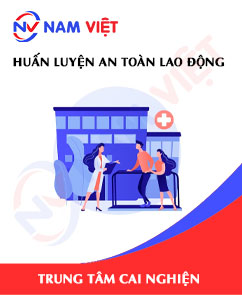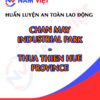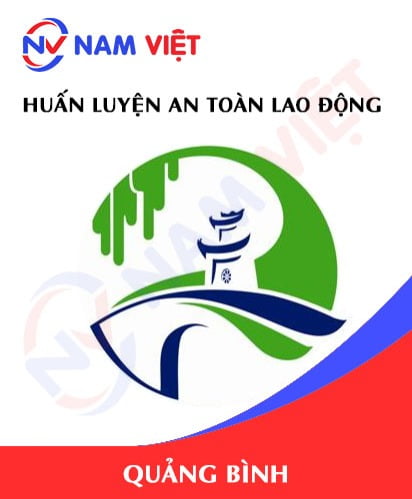Occupational Safety Training at Rehabilitation Centers
99,000 ₫
Note: The above price is calculated per person and may vary depending on the number of trainees participating in the course and market fluctuations. For more accurate pricing support, please refer to the price list or contact our consultants directly.
Occupational safety is an important issue in rehabilitation centers and needs to be addressed promptly to ensure the health and safety of workers, as well as enhance the reputation of businesses operating there. The Occupational Safety Training course is one of the most effective solutions to raise awareness of accident prevention for workers in rehabilitation centers.
Table of Contents
Toggle1. Overview of Rehabilitation Centers
a. What is a rehabilitation center?
Rehabilitation centers are facilities that specialize in providing services and support programs for individuals facing substance abuse issues. The main purpose of these centers is to help individuals recover and reintegrate into society after overcoming addiction to drugs, alcohol, or other substances.
Rehabilitation centers can offer a variety of services, including:
- Counseling and psychological support: Providing individual or group counseling sessions to help addicts understand their problems and learn how to overcome them.
- Medical treatment: Includes medical methods to minimize withdrawal symptoms and help the body recover after stopping substance use.
- Education and training programs: Helping individuals better understand the risks and consequences of substance use, as well as how to change their lifestyle to maintain recovery.
- Social and reintegration support: Activities such as life skills training, job search assistance, and social support to help addicts recover and return to a normal life.
Rehabilitation centers often have different treatment durations and methods depending on the specific needs of each person. They can also operate in various forms, from officially licensed facilities to non-profit community programs.

b. Rehabilitation Centers in Vietnam
In Vietnam, there are many notable rehabilitation centers that provide support services for people addicted to drugs and other substances. These centers not only focus on detoxification but also provide community reintegration programs, helping addicts recover and find a healthy life. Here are some typical rehabilitation centers:
- Drug Counseling and Rehabilitation Center, Ho Chi Minh City: This is one of the largest and most reputable centers in Vietnam. The center provides detoxification services, psychological counseling, and educational programs to help addicts reintegrate into the community. The dedicated and professional staff are always ready to support and guide addicts through the rehabilitation process.
- Hanoi Drug Addiction Treatment and Rehabilitation Center: Located in Hanoi, this center specializes in providing detoxification and rehabilitation services for addicts. The center has comprehensive treatment programs, including psychological therapy and medical support, to help addicts overcome difficulties and stabilize their lives.
- Dong Nai Provincial Center for Labor Education and Vocational Training: In addition to detoxification, this center also focuses on education and vocational training for addicts, helping them become self-sufficient after successful rehabilitation. The vocational training programs here are diverse, from basic to advanced vocational training, suitable for the needs of each individual.
These centers play an important role in supporting and rehabilitating drug addicts, helping them return to a normal life and contribute positively to society.

2. Overview of Safety Training Courses at Rehabilitation Centers
a. What is occupational safety training?
- An occupational safety training course is an in-depth training on occupational safety for people working in industrial, construction, manufacturing, and other high-risk occupations for work-related accidents. This training course is organized by Nam Viet’s occupational safety training centers at the rehabilitation center.
- In this course, trainees will be provided with the necessary knowledge and skills to ensure their own safety and that of their colleagues during work. The topics covered include legal regulations on occupational safety, identification and assessment of potential risks, methods for inspecting and maintaining safety equipment, and first aid and emergency response skills.
- For businesses, providing occupational safety training for employees not only helps enhance their capabilities and work efficiency but also ensures compliance with legal regulations on occupational safety and minimizes the risk of work-related accidents in production and business operations.
REGISTER FOR OCCUPATIONAL SAFETY TRAINING SERVICE
b. Training Duration
The duration of occupational safety training depends on many factors such as the type of work, industry, etc. However, the exact total training time for each group is specified in Article 19 of Decree 44/2016/ND-CP
- Group 1: 16 hours
- Group 2: 48 hours
- Group 3: 24 hours
- Group 4: 16 hours
- Group 5: 16 hours
- Group 6: 4 hours
c. Content of the Training Course
The content of occupational safety training includes the necessary knowledge and skills to minimize the risk of occupational accidents, ensuring the safety of workers and the assets of the business. Specifically, occupational safety training may include the following contents:
- Knowledge of occupational safety laws, state and company regulations on occupational safety.
- Knowledge of risks and types of occupational accidents in the work environment.
- Skills and methods for using personal protective equipment and general protective equipment.
- Methods to minimize the risk of occupational accidents, ensuring safety during work.
- How to handle dangerous situations and how to organize rescue operations in the event of an occupational accident.
- Knowledge of protecting the working environment.
In addition, the training content can be adjusted to suit each specific industry and working condition.
d. Occupational Safety Training Certificate
Occupational Safety and Health Training Certificate
- The template for the occupational safety and health training certificate is described in Form 08, Appendix II of Decree 44/2016/ND-CP and is issued to groups 1, 2, 5, and 6.
- Accordingly, the certificate has a size of 13 cm x 19 cm, and its outer cover is light blue.

- The content on the outside of the certificate is shown in the image above.
- The inside of the certificate has a white background and the content is displayed as below.

- The template for the occupational safety card is described in detail in Form 06, Appendix II of Decree 44/2016/ND-CP.
- Group 3 employees will be issued an occupational safety card (in practice, it is often called a Group 3 occupational safety certificate).
- Accordingly, the card has a size of 60 mm x 90 mm, and the content on the front and back is shown in the image below.

The employer can issue a group 3 safety card to the person who has been trained in occupational safety after passing the examination and there is an employment contract between the two parties.
- The template for the training logbook for groups 1, 2, 5, and 6 is described in detail in Form 09, Appendix II of Decree 44/2016/ND-CP.
- The template for the training logbook for group 3 is described in detail in Form 10, Appendix II of Decree 44/2016/ND-CP.
- The template for the training logbook for group 4 is described in detail in Form 11, Appendix II of Decree 44/2016/ND-CP.
- For group 4, only a training logbook is issued, without a Group 4 safety certificate.
- The content of the group 4 training logbook is shown in the image below.

3. Employment at Rehabilitation Centers
Employment at rehabilitation centers can include various roles and responsibilities, all aimed at supporting the recovery and reintegration of addicts into society. Here are some examples of job positions commonly found at rehabilitation centers:
- Counselor and Psychological Support Specialist: This specialist provides psychological support and individual or group counseling for addicts. The job involves listening and encouraging, helping them understand their problems and develop a recovery plan.
- Healthcare Staff: This includes healthcare professionals such as doctors, nurses, and mental health nurses, who are responsible for health care and managing treatment therapies for addicts.
- Education and Training Specialist: Assigned to provide educational programs on health, life skills, and addiction prevention. They help addicts better understand the harms of addiction and how to change their behavior.
- Social Worker: Provides social support to addicts and their families, helping them overcome difficulties in reintegrating into the community after completing the treatment program.
- Support Staff/Community Advocate: These are individuals who have a role in direct contact with addicts, providing empathetic support and guidance during the recovery process.
- Program Research and Development Specialist: Responsible for researching and developing new treatment methods, evaluating the effectiveness of implemented programs, and improving service quality.
Employment at rehabilitation centers requires staff to have a deep understanding of addiction issues and the ability to work in a sensitive community environment. These positions not only play a crucial role in the treatment process but also contribute positively to improving the quality of life for addicts and the surrounding community.
4. Main Causes of Occupational Accidents at Rehabilitation Centers
- Potential for conflict or violence: Rehabilitation centers often face situations where addicts can become psychologically unstable, leading to conflict or violent behavior. This can pose a risk of injury or assault to staff.
- Quality and safety management of addictive substances: Managing and handling addictive substances like drugs and alcohol in an environment that is not always safe can cause accidents. For example, incidents related to handling or storing addictive substances can lead to contamination or explosions and fires.
- Physical health requirements: Physical activities, such as moving patients or physical activities in treatment programs, can lead to injuries or accidents like slips, falls, and fractures.
- Inadequate safety and protection measures: The lack of protective measures, such as personal protective equipment or safety devices, can increase the risk of accidents for staff during work.
- Environmental factors: Environmental factors such as harsh working conditions, confined spaces, and high work pressure can also play a significant role in causing occupational accidents.
- Lack of training and capacity building: A lack of training or capacity building for staff on safety measures and risk management can reduce their ability to identify and prevent accidents.

5. Measures to Control Occupational Accidents in Rehabilitation Centers
- Risk Assessment and Safety Planning:
- Conduct regular occupational risk assessments to identify potential hazards and propose preventive measures.
- Develop a detailed occupational safety plan, including specific measures to minimize risks and protect staff and addicts.
- Ensuring Personal Protective Measures:
- Provide adequate personal protective equipment (including helmets, safety shoes, safety glasses, gloves) for staff during work.
- Encourage and supervise the correct use of personal protective equipment.
- Training and Awareness Raising:
- Provide regular training on occupational safety and risk management for all staff.
- Specifically, train staff on preventive measures and how to respond to conflicts and violent behavior from addicts.
- Monitoring and Effectiveness Evaluation:
- Implement strict monitoring to ensure compliance with occupational safety regulations and the effectiveness of preventive measures.
- Organize periodic inspections and re-evaluate safety programs to adjust and improve as needed.
- Quality Management and Health Issues:
- Apply quality management procedures for handling and storing addictive substances to minimize the risk of chemical accidents.
- Ensure that hygiene and health standards are strictly implemented to prevent infectious diseases and protect the health of staff and addicts.
- Psychological Support and Reintegration:
- Pay special attention to the mental health of staff, providing support and regular monitoring to minimize work-related stress and the risk of conflicts.
- Periodically organize occupational environmental monitoring in rehabilitation centers, collecting and analyzing harmful factors for workers, thereby adjusting to reduce hazard levels to prevent occupational diseases for them.

6. Benefits of Occupational Safety Training
An Toan Nam Viet provides your business with the following great benefits after completing occupational safety training courses as prescribed in Decree 44/2016/ND-CP on Occupational Safety and Health for companies, factories, and enterprises.
- Employees can identify potential risks of occupational accidents and take preventive measures to avoid them.
- Your business can establish risk prevention measures in production, operation, and maintenance processes.
- Reduce costs when there is a risk of occupational safety hazards.
- Uninterrupted production processes will help increase labor productivity and product quality.
- Comply with regulations on occupational safety laws, avoiding legal risks.
- Create credibility and professionalism in all aspects, thereby enhancing the brand of your business.
Nam Viet’s training courses are the solution to prevent and combat external factors affecting each individual so they can avoid dangers that could lead to injury or, more seriously, death.
REGISTER FOR OCCUPATIONAL SAFETY TRAINING SERVICE
7. Customer Feedback After Completing the Training Course
An Toan Nam Viet has many years of experience in its mission to accompany many businesses in Vietnam in general and in the southern provinces in particular. And this responsibility is something very precious to Nam Viet, which is why Nam Viet’s Occupational Safety Training is always focused on becoming more professional. The motivation for An Toan Nam Viet to grow strong to this day comes from both positive feedback and suggestions from businesses. Below is the feedback from our partners we have served.
Bac Nam E&C Construction Investment Joint Stock Company
Hoa Dat Construction and Trading Joint Stock Company
See more customer interviews after using the service of An Toan Nam Viet
8. Occupational Safety Training Capacity of An Toan Nam Viet
An Toan Nam Viet is a reputable and high-quality occupational safety training center in Vietnam today. Our occupational safety training sessions are held continuously at production workshops, factories, or construction sites across the country (63 provinces in Vietnam).
REGISTER FOR OCCUPATIONAL SAFETY TRAINING SERVICE
Occupational safety training license
- An Toan Nam Viet has been inspected and certified by the Department of Work Safety of the Ministry of Labor – Invalids and Social Affairs as being qualified to conduct occupational safety and health training. This further strengthens our capacity in occupational safety training.

Documents and lectures
- Before occupational safety training materials are used in our occupational safety training courses, they are reviewed and approved to ensure that the lectures are always accurate in knowledge and effective when applied.
- The teaching methods of our instructors are standardized according to the teaching standards of An Toan Nam Viet, a method that our experts in occupational safety and health training have researched and refined during the teaching process to bring the highest knowledge absorption efficiency to trainees.
Facilities
- Controlling factors in the classroom that affect the training process will increase teaching efficiency and the trainees’ knowledge absorption.
- Our training course support facilities always arrange spacious classrooms that meet standards for area, lighting, training equipment, etc.
9. Nationwide Reputable and Quality Safety Training Center
At An Toan Nam Viet, we always prioritize our professional dedication to occupational safety training. For us, imparting the knowledge of self-protection to workers so they have a safe foundation on their path to earning a living contributes to building the country.
To ensure effective training, we prepare carefully and meticulously, down to the smallest detail. From preparing tools, instruments, teaching equipment to curricula, materials, sound, and lighting.
Our occupational safety training instructors are experts with many years of experience in the field. They even have research works identifying hazards in all industries and how to prevent them.
The instructor’s lectures are drawn from practical experience and conveyed in the most vivid and easy-to-understand way to the workers. These factors help workers feel comfortable during their study time and absorb our teaching knowledge well. Of course, the knowledge conveyed always adheres to Decree 44/2016/ND-CP.
From there, they grasp many measures to prevent hazards and how to protect themselves. At the same time, they can apply it most appropriately in their actual work.
Our safety training center is proud to be a reputable and professional provider of occupational safety training services with the following advantages:
- Competitive training costs while still ensuring training quality.
- Flexible training schedules to suit the production situation of companies and enterprises.
- Quick and legally compliant procedures for issuing occupational safety training certificates.
- Training instructors are those with many years of experience in the profession.
- Classrooms are controlled for factors affecting the training process, increasing teaching efficiency and the effectiveness of knowledge absorption by trainees.
- Lectures are compiled to be suitable for occupational safety work at businesses.
- An Toan Nam Viet works with dedication and professionalism to support customers accurately and quickly.

10. Further Reference for Occupational Safety Training Materials
No comments yet














Review Occupational Safety Training at Rehabilitation Centers
There are no reviews yet.